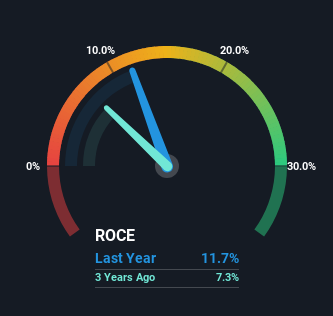Finding a business that has the potential to grow substantially is not easy, but it is possible if we look at a few key financial metrics. Firstly, we’d want to identify a growing return on capital employed (ROCE) and then alongside that, an ever-increasing base of capital employed. Basically this means that a company has profitable initiatives that it can continue to reinvest in, which is a trait of a compounding machine. However, after investigating Lear (NYSE:LEA), we don’t think it’s current trends fit the mold of a multi-bagger.
Return On Capital Employed (ROCE): What Is It?
For those that aren’t sure what ROCE is, it measures the amount of pre-tax profits a company can generate from the capital employed in its business. Analysts use this formula to calculate it for Lear:
Return on Capital Employed = Earnings Before Interest and Tax (EBIT) ÷ (Total Assets – Current Liabilities)
0.12 = US$1.1b ÷ (US$15b – US$5.7b) (Based on the trailing twelve months to December 2023).
Therefore, Lear has an ROCE of 12%. In absolute terms, that’s a pretty normal return, and it’s somewhat close to the Auto Components industry average of 11%.
See our latest analysis for Lear
In the above chart we have measured Lear’s prior ROCE against its prior performance, but the future is arguably more important. If you’d like, you can check out the forecasts from the analysts covering Lear for free.
The Trend Of ROCE
In terms of Lear’s historical ROCE movements, the trend isn’t fantastic. To be more specific, ROCE has fallen from 24% over the last five years. Although, given both revenue and the amount of assets employed in the business have increased, it could suggest the company is investing in growth, and the extra capital has led to a short-term reduction in ROCE. If these investments prove successful, this can bode very well for long term stock performance.
Our Take On Lear’s ROCE
Even though returns on capital have fallen in the short term, we find it promising that revenue and capital employed have both increased for Lear. In light of this, the stock has only gained 0.1% over the last five years. So this stock may still be an appealing investment opportunity, if other fundamentals prove to be sound.
Lear does have some risks though, and we’ve spotted 1 warning sign for Lear that you might be interested in.
If you want to search for solid companies with great earnings, check out this free list of companies with good balance sheets and impressive returns on equity.
Have feedback on this article? Concerned about the content? Get in touch with us directly. Alternatively, email editorial-team (at) simplywallst.com.
This article by Simply Wall St is general in nature. We provide commentary based on historical data and analyst forecasts only using an unbiased methodology and our articles are not intended to be financial advice. It does not constitute a recommendation to buy or sell any stock, and does not take account of your objectives, or your financial situation. We aim to bring you long-term focused analysis driven by fundamental data. Note that our analysis may not factor in the latest price-sensitive company announcements or qualitative material. Simply Wall St has no position in any stocks mentioned.
